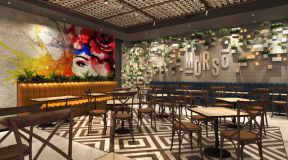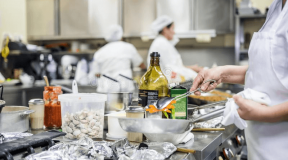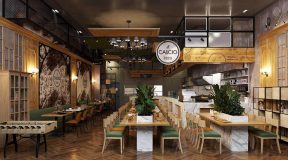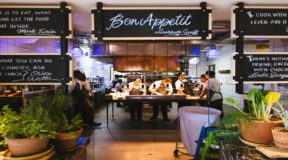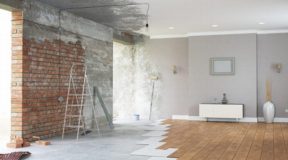Restaurants have been a part of popular culture for a very long time. However, the demand for good restaurants has sky-rocketed in the fast paced, social media centric times that we live in. The restaurant industry never ceases to thrive, with or without a pandemic. It is now back in full force after a slight slowdown due to the ongoing health advisories. With the industry back in bloom, comes a lot of competition and hustle to be in the business and succeed at it.

In the process of crafting the menu and deciding the theme, the first and foremost factor that should be considered while starting a restaurant business often gets neglected, which is the location. Of course, food services and staff are crucial factors but appropriate location is the master key to success of any restaurant. The choice of location has the capability to either thrive or tank the business specially at the early stages, which is why choosing the perfect location is a herculean task. The key is to not be impulsive, research adequately and have an apt business plan.
Here are some of the factors to be considered while deciding the location for restaurants-
- Concept, clientele and budget
- Site location and specifications
- Visibility, accessibility and parking
- Footfall and demographics
- Competition and neighbourhood behaviour
Concept, clientele and budget
Location should suit the theme and concept of the restaurant, i.e. whether it is a fine dine, cafe, bakery, fast food or take away. Target audience and neighbourhood has a large part to play for the location to be appropriate.
Budget is an important factor to be kept in mind while selecting the location. The affordability of the space can massively affect the success and profit. It is crucial to choose whether to buy a property for long term or rent it for short term. High rentals can be a major reason for failure of restaurants if they do not make enough profit.
Real estate market trends like upcoming rise of costs in the leasing sector etc. should be kept in mind to manage the finances. The cue is to keep looking at various options and checking the utilities and technical capabilities before settling on any property.
Another important thing to be specifically taken care of in a rented property is the rent agreement and negotiation with the landlord about what all is included in the rent and what additional charges are to be borne by the tenant, or what maintenance charges are going to add up, for example, electricity and water bill, small repairs, house keeping, etc.

Site location and specifications
As much as correct marketing space is important, it is crucial to keep in mind the specifications that a particular site provides. A detailed survey by a professional designer needs to be carried out, which should include key points like actual usable carpet, checking structural strength, well finished bare shell walls, electricity supply and required loads, water supply, water seepage, site facing, terrace availability for overhead tanks or solar panels. It further includes checking windows, glazing and toughened glass finishes for larger panels, air-conditioning, light and ventilation, utilities, emergency exit, food safety norms, zoning and restrictions.
Research about the history of the space, the previous owners or tenants and their reasons for leaving the property that may affect your business in the times to come. Another important factor to focus on is the landlord’s behaviour, transaction transparency and support towards the business to maintain a healthy long term relationship. It is a good idea to conduct a due diligence with neighbouring stores and previous tenants to get a detailed review about it.
Before finalising a site, a site feasibility analysis needs to be carried out. A professional can be hired for a nominal fee, who can submit a Site Analysis Report (SAR) which can then be used to determine capital expenditures, negotiations with landlord and various other business requirements like loans, business viability, etc.
A restaurant is not run on just good food, it also requires appropriate layout and construction. Before choosing a site, it is important to check the size of the site, and hire respective professionals like restaurant specialised interior designers to design a functional layout so that it is convenient for the public to approach the space.
Check with the local planning authorities for any future development plans that may affect your restaurant business such as additional buildings nearby or road construction etc.

Visibility, accessibility and parking
To thrive in the business, the restaurant needs to catch the eye of the customers. To achieve more visibility, it is important to choose an area that gets relevant traffic based on the theme of the restaurant. The chances of success are more if the restaurant is located on ground floor so that it is easily accessible to people.
Signage plays a great part in making the restaurant visible and popular as well. Striking signage and catchy tag lines can imbibe in the minds of customers or passers-by very effectively.
Accessibility should be measured in terms of convenience to all kinds of customers, i.e. it should have suitable stairs as well as ramp for the comfort of customers. It may not sound too important but plays a great role on the psyche of the customer, since a lot of footfall in the restaurant will be of the pedestrian traffic.
Select a location that provides adequate parking services because that can be a factor that attracts or turns a lot of customers away. The easier it is to park near the restaurant, the more likely it is for the people to remember your service and come back for more.

Footfall and demographics
Calculating the average footfall in the locality, their age, family size, income, etc. can go a long way in the success of your business. It is beneficial to decide a target audience and set up your restaurant accordingly. For example, if your target audience is youngsters, it is a good idea to find a location near college campuses and schools or plazas and shopping complexes if your target audience is nuclear families. The study of nearby businesses and their footfall can enhance your approach towards targeting your audience. You should also look at both highway and foot traffic to determine the kind of audience you’re catering to.
The demographics also need to be calculated for your wholesalers and suppliers. The delivery costs, loading and unloading costs can play a pivotal role in managing the finances. The business cannot thrive without a strong team of people coming together to build a success story.

Competition and neighbourhood behaviour
Even if you have chosen the most apt restaurant themes, you need to be aware of what surrounds you. Competition has its own advantages and disadvantages while locating your restaurant. Although you would need to work harder and smarter to attract customers, the advantage is an increase in the footfall since being close to well-established competitors can help lure more audience.
You would need keep a keen eye on market trends and use them to amplify your business.
It is also necessary to keep healthy relationships with your neighbours to sustain in the business for a long term. The businesses can help each other grow and build a flourishing community. You can also use their demographics to make advancements to your restaurant according to the needs of the customers. Moreover, building a business near strong competitors adds a note-worthy distinction to your restaurant.
Also, neighbourhood behaviour plays a pivotal role in deciding the theme, menu and timings of the restaurant. Whether you want a dine in, take away, breakfast or lunch place, is decided by what kind of population visits the area, for example, office goers, college students, tourists, etc.

Conclusion
Of course, it’s a good idea to make your own evaluations of a particular property, but addressing all these determining elements while choosing the location for your restaurant is bound to bear fruits for your business. A subsequent growth can be made in the business by taking suitable professional help in understanding and dealing with all these factors.
Remember that checking and analysing every line item of your expense sheet on the basis of cost savings and efficiencies truly determines the success of your restaurant. Therefore, it is ideal practice it from the beginning, specially while choosing the location for your restaurant.
After all, in the brick and mortar retail world, it’s said that the three most important decisions are location, location, and location!

